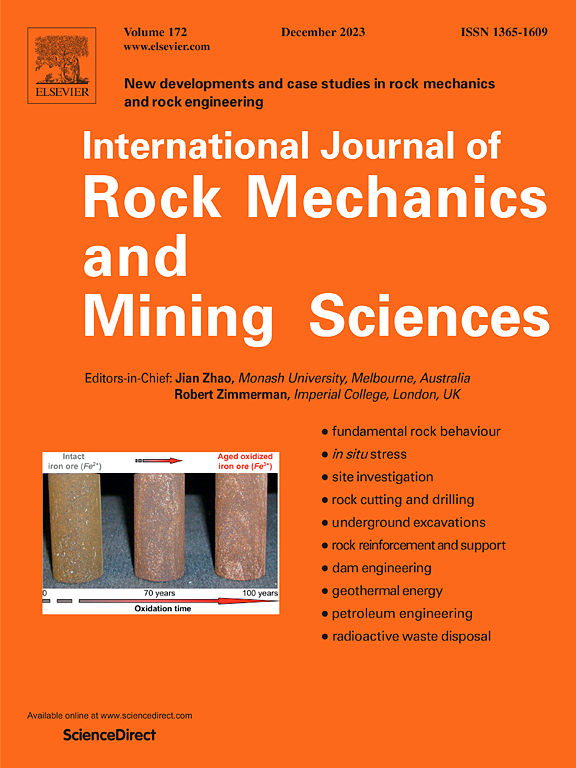Hard rock fragmentation by dynamic conical pick indentation under confining pressure
IF 7
1区 工程技术
Q1 ENGINEERING, GEOLOGICAL
International Journal of Rock Mechanics and Mining Sciences
Pub Date : 2024-10-11
DOI:10.1016/j.ijrmms.2024.105932
引用次数: 0
Abstract
Mechanical mining and excavation in deep metal mines can be regarded as the process of crushing hard rock by conical pick indentation. In this study, a confining pressure loading device was designed and used to carry out dynamic conical pick indentation crushing tests under confining pressure conditions on three types of granite with varying strengths, using the Split Hopkinson Pressure Bar (SHPB). The objective was to quantitatively investigate the effect of confining pressure and rock strength on the indentation crushing characteristics of deep hard rocks. The results indicate that as the confining pressure increases from 5 MPa to 20 MPa, the dimensional parameters such as volume, diameter and depth of the impact groove decrease linearly, while parameters such as the specific energy, indentation force, indentation index and energy utilization rate progressively increase. The increase in the confining pressure inhibits the formation of internal cracks in the rock, enhancing its resistance to pick indentation, which in turn makes rock fragmentation more difficult. This creates unfavorable conditions for efficient rock breaking. Furthermore, rock strength plays a crucial role in the pick indentation process. The higher the rock strength, the greater its resistance to pick indentation, leading to increased energy consumption, accelerated wear of the conical picks, and reduced efficiency in rock breaking.
在约束压力下通过动态锥形镐压痕破碎硬岩
深部金属矿山的机械采矿和挖掘可视为通过锥形镐压痕破碎坚硬岩石的过程。本研究设计了一种封闭压力加载装置,并利用分体式霍普金森压力棒(SHPB)对三种不同强度的花岗岩进行了封闭压力条件下的动态锥形镐压痕破碎试验。目的是定量研究封闭压力和岩石强度对深层硬岩压痕破碎特性的影响。结果表明,随着约束压力从 5 兆帕增加到 20 兆帕,冲击槽的体积、直径和深度等尺寸参数呈线性下降,而比能、压痕力、压痕指数和能量利用率等参数则逐渐增加。约束压力的增加抑制了岩石内部裂缝的形成,增强了岩石对镐压痕的抵抗力,这反过来又增加了岩石破碎的难度。这就为高效破岩创造了不利条件。此外,岩石强度在镐头压入过程中起着至关重要的作用。岩石强度越高,对镐头压入的阻力就越大,从而导致能耗增加、锥形镐头磨损加快、破岩效率降低。
本文章由计算机程序翻译,如有差异,请以英文原文为准。
求助全文
约1分钟内获得全文
求助全文
来源期刊
CiteScore
14.00
自引率
5.60%
发文量
196
审稿时长
18 weeks
期刊介绍:
The International Journal of Rock Mechanics and Mining Sciences focuses on original research, new developments, site measurements, and case studies within the fields of rock mechanics and rock engineering. Serving as an international platform, it showcases high-quality papers addressing rock mechanics and the application of its principles and techniques in mining and civil engineering projects situated on or within rock masses. These projects encompass a wide range, including slopes, open-pit mines, quarries, shafts, tunnels, caverns, underground mines, metro systems, dams, hydro-electric stations, geothermal energy, petroleum engineering, and radioactive waste disposal. The journal welcomes submissions on various topics, with particular interest in theoretical advancements, analytical and numerical methods, rock testing, site investigation, and case studies.

 求助内容:
求助内容: 应助结果提醒方式:
应助结果提醒方式:


